Abstract
The controversial nature of drug treatment of hyperactivity, the incidence and sequelae of hyperactivity, and problems of differential diagnosis of hyperactivity versus aggression were discussed. The effects of psychostimulant medication and behavior therapy on hyperactive children were reviewed with regard to effects on their social and academic behavior. Both treatments have resulted in clear short-term changes in social behavior but neither long-term academic nor long-term social effects have been shown with either treatment. Short-term effects on academic behavior have resulted from behavioral interventions but not from psychostimulants. However, the interventions have been too brief to allow one to draw unequivocal conclusions about the clinical efficacy of behavioral treatments. Although there have been long-term evaluations of psychostimulant therapy, there have not been any evaluations of long-term behavioral treatment programs for hyperactive children. Given the salutary short-term effects of behavior therapy with hyperactive children, extended clinical trials of behavior therapy need to be conducted. Finally, specific directions are suggested for future research.
Full text
PDF
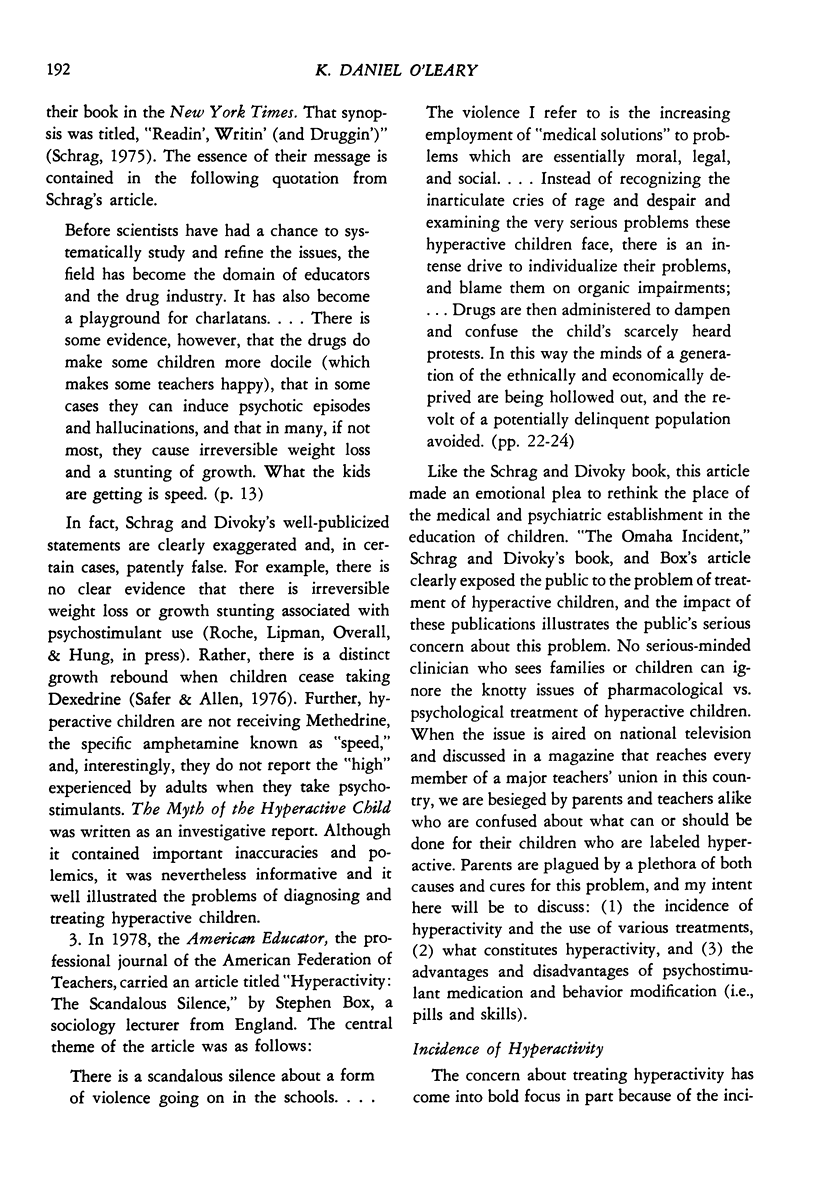

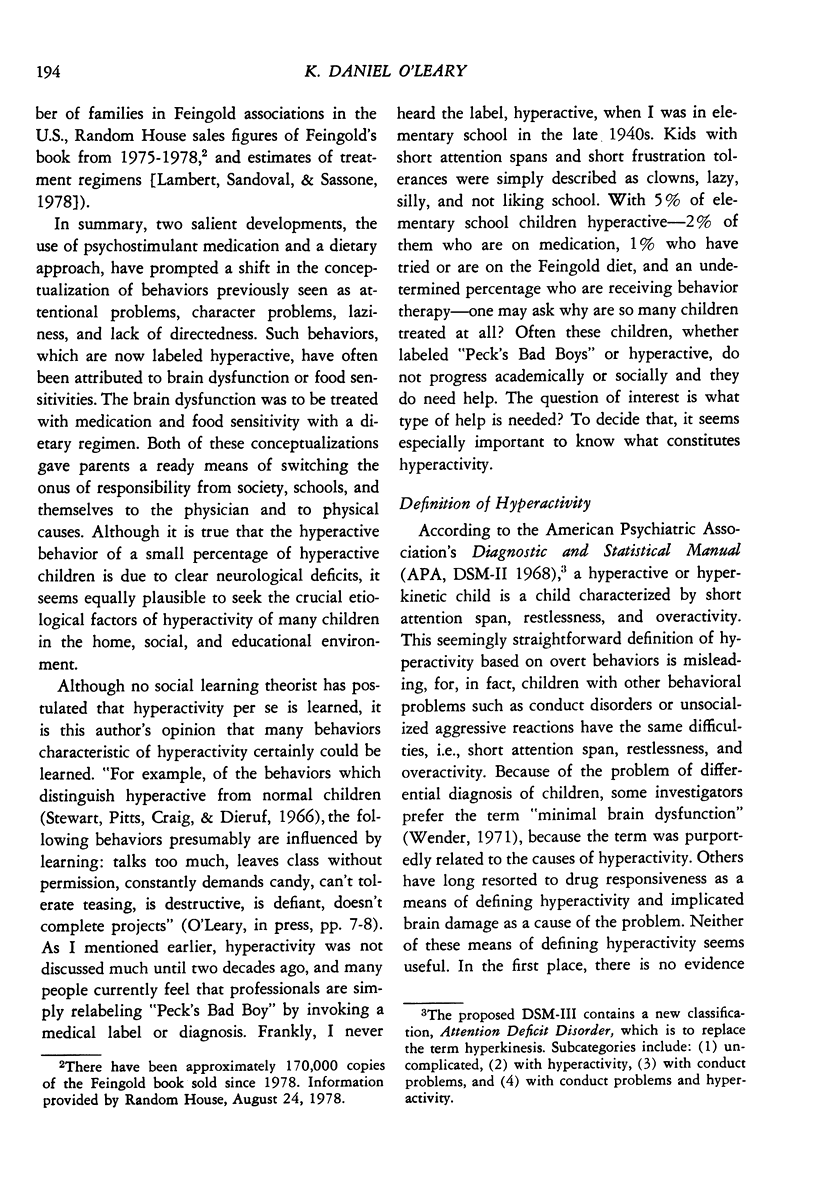



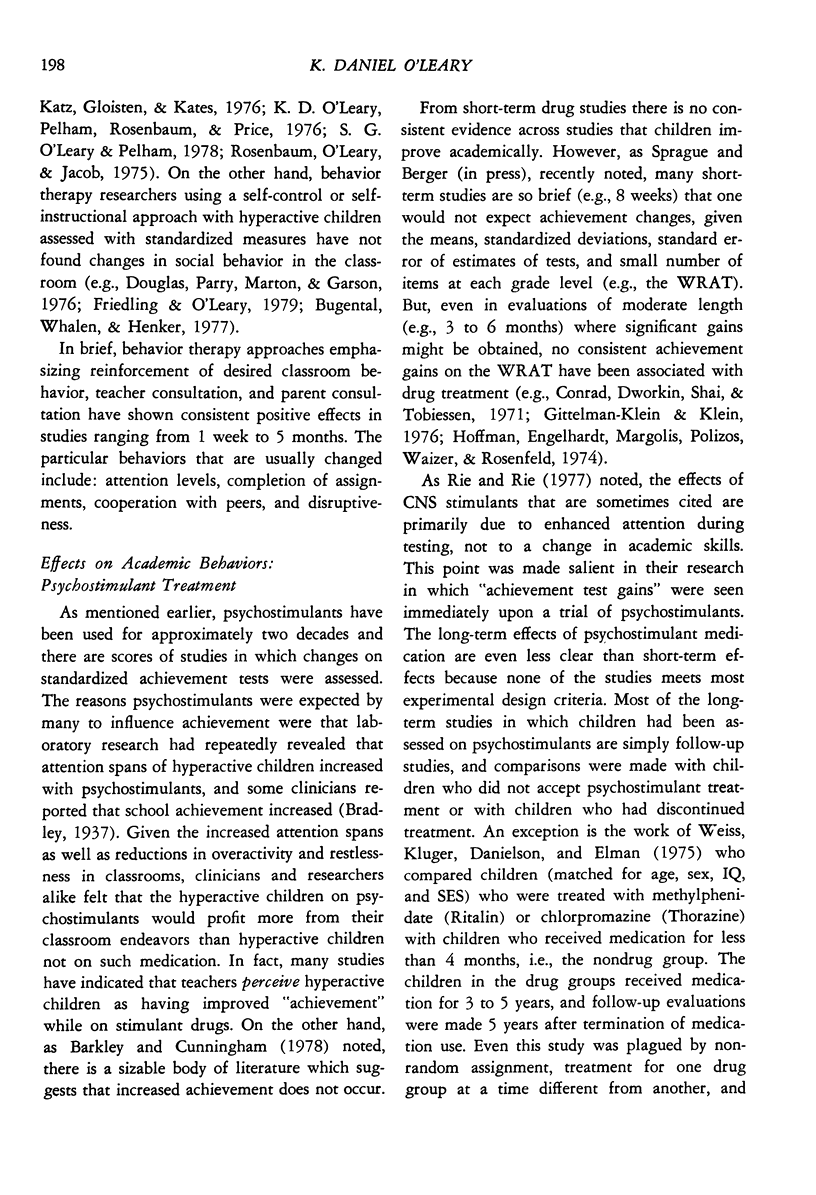
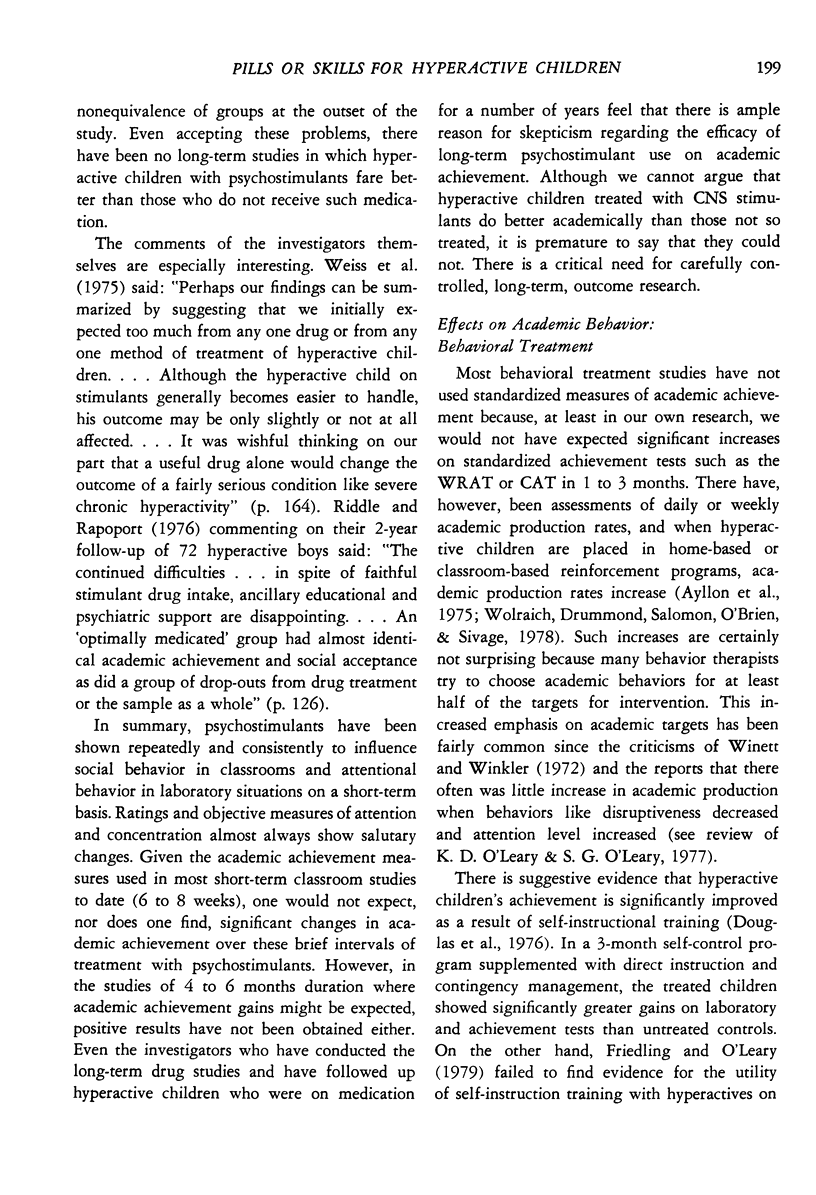


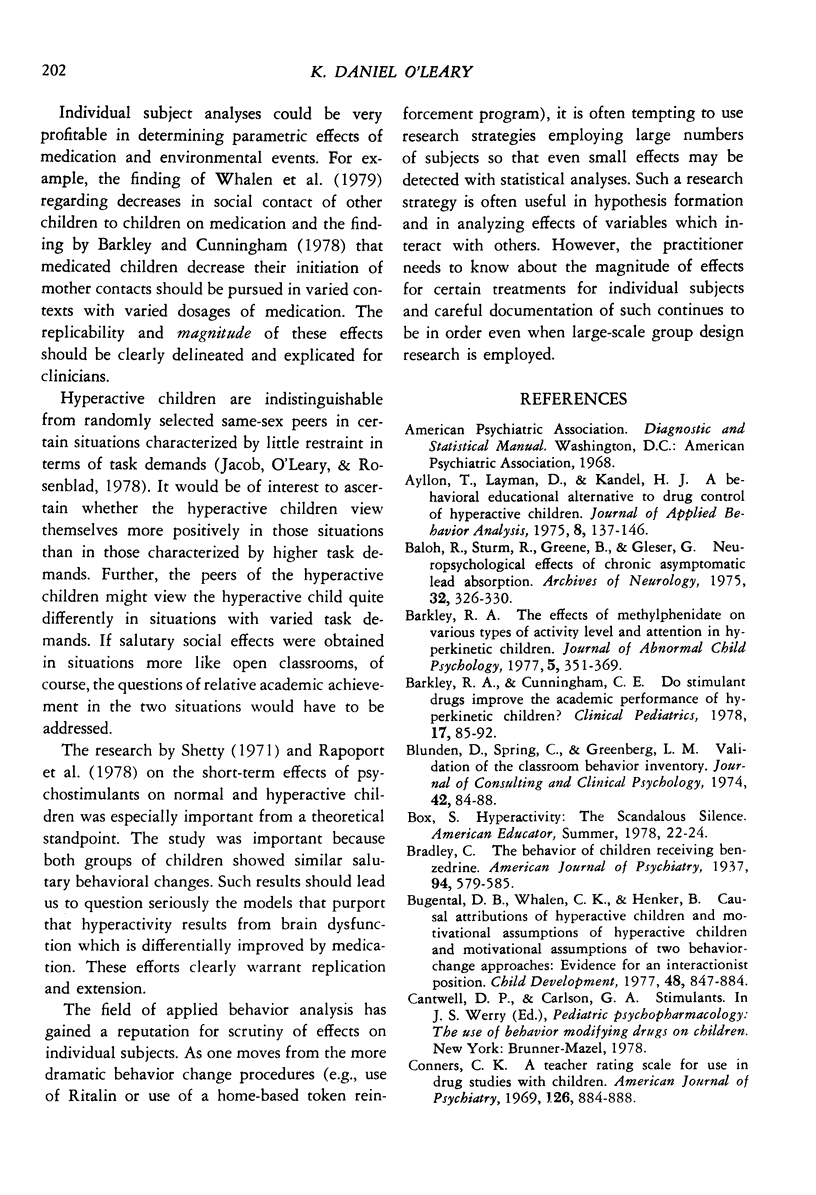


Selected References
These references are in PubMed. This may not be the complete list of references from this article.
- Ayllon T., Layman D., Kandel H. J. A behavioral-educational alternative to drug control of hyperactive children. J Appl Behav Anal. 1975 Summer;8(2):137–146. doi: 10.1901/jaba.1975.8-137. [DOI] [PMC free article] [PubMed] [Google Scholar]
- Baloh R., Sturm R., Green B., Gleser G. Neuropsychological effects of chronic asymptomatic increased lead absorption. A controlled study. Arch Neurol. 1975 May;32(5):326–330. doi: 10.1001/archneur.1975.00490470070010. [DOI] [PubMed] [Google Scholar]
- Barkley R. A., Cunningham C. E. Do stimulant drugs improve the academic performance of hyperkinetic children? A review of outcome studies. Clin Pediatr (Phila) 1978 Jan;17(1):85–92. doi: 10.1177/000992287801700112. [DOI] [PubMed] [Google Scholar]
- Barkley R. A. The effects of methylphenidate on various types of activity level and attention in hyperkinetic children. J Abnorm Child Psychol. 1977 Dec;5(4):351–369. doi: 10.1007/BF00915084. [DOI] [PubMed] [Google Scholar]
- Blunden D., Spring C., Greenberg L. M. Validation of the Classroom Behavior Inventory. J Consult Clin Psychol. 1974 Feb;42(1):84–88. doi: 10.1037/h0035905. [DOI] [PubMed] [Google Scholar]
- Conners C. K. A teacher rating scale for use in drug studies with children. Am J Psychiatry. 1969 Dec;126(6):884–888. doi: 10.1176/ajp.126.6.884. [DOI] [PubMed] [Google Scholar]
- Douglas V. I., Parry P., Marton P., Garson C. Assessment of a cognitive training program for hyperactive children. J Abnorm Child Psychol. 1976;4(4):389–410. doi: 10.1007/BF00922535. [DOI] [PubMed] [Google Scholar]
- Epstein L. H., Masek B. J. Behavioral control of medicine compliance. J Appl Behav Anal. 1978 Spring;11(1):1–9. doi: 10.1901/jaba.1978.11-1. [DOI] [PMC free article] [PubMed] [Google Scholar]
- Friedling C., O'Leary S. G. Effects of self-instructional training on second- and third-grade hyperactive children: a failure to replicate. J Appl Behav Anal. 1979 Summer;12(2):211–219. doi: 10.1901/jaba.1979.12-211. [DOI] [PMC free article] [PubMed] [Google Scholar]
- Gittelman-Klein R., Klein D. F., Abikoff H., Katz S., Gloisten A. C., Kates W. Relative efficacy of methylphenidate and behavior modification in hyperkinetic children: an interim report. J Abnorm Child Psychol. 1976;4(4):361–379. doi: 10.1007/BF00922533. [DOI] [PubMed] [Google Scholar]
- Gittleman-Klein R., Klein D. F. Methylphenidate effects in learning disabilities. Psychometric changes. Arch Gen Psychiatry. 1976 Jun;33(6):655–664. doi: 10.1001/archpsyc.1976.01770060003001. [DOI] [PubMed] [Google Scholar]
- Hoffman S. P., Engelhardt D. M., Margolis R. A., Polizos P., Waizer J., Rosenfeld R. Response to methylphenidate in low socioeconomic hyperactive children. Arch Gen Psychiatry. 1974 Mar;30(3):354–359. doi: 10.1001/archpsyc.1974.01760090064011. [DOI] [PubMed] [Google Scholar]
- Jacob R. G., O'Leary K. D., Rosenblad C. Formal and informal classroom settings: effects on hyperactivity. J Abnorm Child Psychol. 1978 Mar;6(1):47–59. doi: 10.1007/BF00915781. [DOI] [PubMed] [Google Scholar]
- Kent R. N., O'Leary K. D. A controlled evaluation of behavior modification with conduct problem children. J Consult Clin Psychol. 1976 Aug;44(4):586–596. doi: 10.1037//0022-006x.44.4.586. [DOI] [PubMed] [Google Scholar]
- Krager J. M., Safer D., Earhart J. Follow-up survey results of medication used to treat hyperactive school children. J Sch Health. 1979 Jun;49(6):317–321. doi: 10.1111/j.1746-1561.1979.tb07722.x. [DOI] [PubMed] [Google Scholar]
- Lambert N. M., Sandoval J., Sassone D. Prevalence of hyperactivity in elementary school children as a function of social system definers. Am J Orthopsychiatry. 1978 Jul;48(3):446–463. doi: 10.1111/j.1939-0025.1978.tb01334.x. [DOI] [PubMed] [Google Scholar]
- Loney J., Langhorne J. E., Jr, paternite C. E. Empirical basis for subgrouping the hyperkinetic/minimal brain dysfunction syndrome. J Abnorm Psychol. 1978 Aug;87(4):431–441. doi: 10.1037//0021-843x.87.4.431. [DOI] [PubMed] [Google Scholar]
- Needleman H. L., Gunnoe C., Leviton A., Reed R., Peresie H., Maher C., Barrett P. Deficits in psychologic and classroom performance of children with elevated dentine lead levels. N Engl J Med. 1979 Mar 29;300(13):689–695. doi: 10.1056/NEJM197903293001301. [DOI] [PubMed] [Google Scholar]
- O'Leary K. D., Pelham W. E., Rosenbaum A., Price G. H. Behavioral treatment of hyperkinetic children. An experimental evaluation of its usefulness. Clin Pediatr (Phila) 1976 Jun;15(6):510–515. doi: 10.1177/000992287601500603. [DOI] [PubMed] [Google Scholar]
- O'Leary S. G., Pelham W. E. Behavior therapy and withdrawal of stimulant medication in hyperactive children. Pediatrics. 1978 Feb;61(2):211–217. [PubMed] [Google Scholar]
- Rapoport J. L., Buchsbaum M. S., Zahn T. P., Weingartner H., Ludlow C., Mikkelsen E. J. Dextroamphetamine: cognitive and behavioral effects in normal prepubertal boys. Science. 1978 Feb 3;199(4328):560–563. doi: 10.1126/science.341313. [DOI] [PubMed] [Google Scholar]
- Riddle K. D., Rapoport J. L. A 2-year follow-up of 72 hyperactive boys. Classroom behavior and peer acceptance. J Nerv Ment Dis. 1976 Feb;162(2):126–134. doi: 10.1097/00005053-197602000-00007. [DOI] [PubMed] [Google Scholar]
- Rutter M. Brain damage syndromes in childhood: concepts and findings. J Child Psychol Psychiatry. 1977 Jan;18(1):1–21. doi: 10.1111/j.1469-7610.1977.tb00413.x. [DOI] [PubMed] [Google Scholar]
- Safer D., Allen R., Barr E. Depression of growth in hyperactive children on stimulant drugs. N Engl J Med. 1972 Aug 3;287(5):217–220. doi: 10.1056/NEJM197208032870503. [DOI] [PubMed] [Google Scholar]
- Satterfield J. H., Cantwell D. P., Satterfield B. T. Multimodality treatment. A one-year follow-up of 84 hyperactive boys. Arch Gen Psychiatry. 1979 Aug;36(9):965–974. doi: 10.1001/archpsyc.1979.01780090051006. [DOI] [PubMed] [Google Scholar]
- Shetty T. Photic responses in hyperkinesis of childhood. Science. 1971 Dec 24;174(4016):1356–1357. doi: 10.1126/science.174.4016.1356. [DOI] [PubMed] [Google Scholar]
- Sprague R. L., Sleator E. K. Methylphenidate in hyperkinetic children: differences in dose effects on learning and social behavior. Science. 1977 Dec 23;198(4323):1274–1276. doi: 10.1126/science.337493. [DOI] [PubMed] [Google Scholar]
- Stewart M. A., Pitts F. N., Jr, Craig A. G., Dieruf W. The hyperactive child syndrome. Am J Orthopsychiatry. 1966 Oct;36(5):861–867. doi: 10.1111/j.1939-0025.1966.tb02414.x. [DOI] [PubMed] [Google Scholar]
- Swanson J., Kinsbourne M., Roberts W., Zucker K. Time-response analysis of the effect of stimulant medication on the learning ability of children referred for hyperactivity. Pediatrics. 1978 Jan;61(1):21–29. [PubMed] [Google Scholar]
- Weiss G., Kruger E., Danielson U., Elman M. Effect of long-term treatment of hyperactive children with methylphenidate. Can Med Assoc J. 1975 Jan 25;112(2):159–165. [PMC free article] [PubMed] [Google Scholar]
- Werry J. S., Sprague R. L., Cohen M. N. Conners' Teacher Rating Scale for use in drug studies with children--an empirical study. J Abnorm Child Psychol. 1975;3(3):217–229. doi: 10.1007/BF00916752. [DOI] [PubMed] [Google Scholar]
- Whalen C. K., Henker B., Collins B. E., Finck D., Dotemoto S. A social ecology of hyperactive boys: medication effects in structured classroom environments. J Appl Behav Anal. 1979 Spring;12(1):65–81. doi: 10.1901/jaba.1979.12-65. [DOI] [PMC free article] [PubMed] [Google Scholar]
- Winett R. A., Winkler R. C. Current behavior modification in the classroom: be still, be quiet, be docile. J Appl Behav Anal. 1972 Winter;5(4):499–504. doi: 10.1901/jaba.1972.5-499. [DOI] [PMC free article] [PubMed] [Google Scholar]
- Winsberg B. G., Yepes L. E., Bialer I. Pharmacologic management of children with hyperactive/aggressive/inattentive behavior disorders. Suggestions for the pediatrician. Clin Pediatr (Phila) 1976 May;15(5):471–477. doi: 10.1177/000992287601500512. [DOI] [PubMed] [Google Scholar]
- Wolraich M., Drummond T., Salomon M. K., O'Brien M. L., Sivage C. Effects of methylphenidate alone and in combination with behavior modification procedures on the behavior and academic performance of hyperactive children. J Abnorm Child Psychol. 1978 Mar;6(1):149–161. doi: 10.1007/BF00915790. [DOI] [PubMed] [Google Scholar]
- Zukow P. G., Zukow A. H., Bentler P. M. Rating scales for the identification and treatment of hyperkinesis. J Consult Clin Psychol. 1978 Apr;46(2):213–222. doi: 10.1037//0022-006x.46.2.213. [DOI] [PubMed] [Google Scholar]


